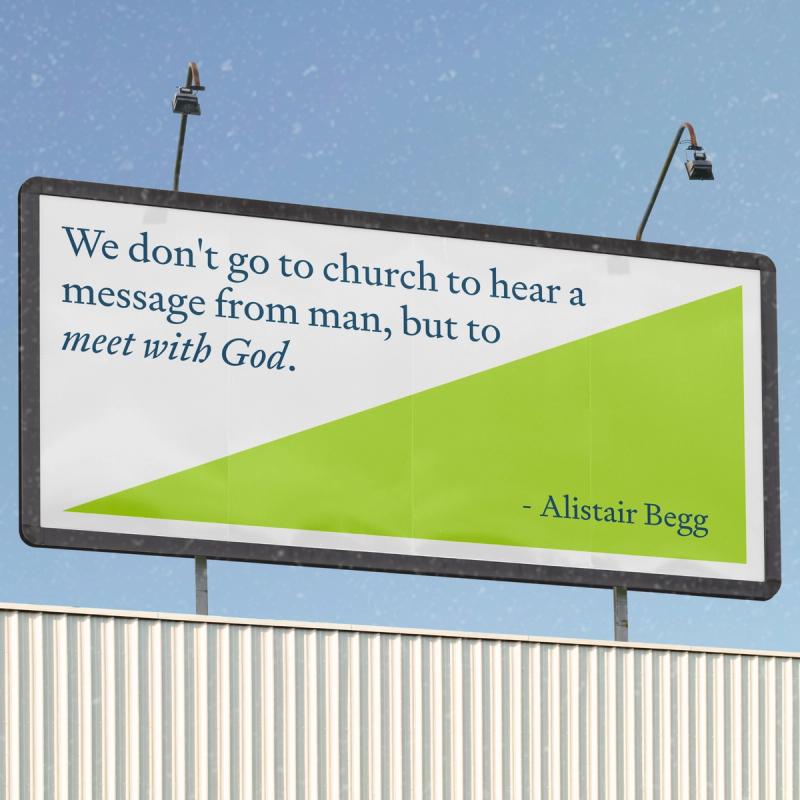I have a vivid recollection as a small boy of sitting in St. George’s Tron Church in Glasgow waiting for the commencement of morning worship. At about three minutes to eleven, the beadle (parish official) would climb the pulpit stairs and place a large Bible on the lectern. Having opened it to the appropriate passage, he would descend, and the minister would in turn ascend the stairs and sit in the cone-shaped pulpit. The beadle would complete his responsibilities by climbing the stairs a second time to close the pulpit door and leave the pastor to his task. There was no doubt, in my young mind, that each part of that procedure was marked with significance. There was clearly no reason for the pastor to be in the pulpit apart from the Bible upon which he looked down as he read. I understood that, in contrast to his physical posture, the preacher was standing under Scripture, not over it. Similarly, we were listening not so much for his message but for its message. We were discovering, as J. I. Packer has suggested, that preaching is “letting texts talk.”
Sadly, much of what now emanates from pulpits would not be recognized by many Christians of past generations as anywhere close to the kind of expository preaching that is Bible-based, Christ-focused, and life-changing—the kind of preaching that is marked by doctrinal clarity, a sense of gravity, and convincing argument. We have instead become far too familiar with preaching that pays scant attention to the Bible, is self-focused, and consequently is capable of only the most superficial impact upon the lives of listeners. Worse still, large sections of the church are oblivious to the fact that they are being administered a placebo rather than the medicine they need. They are satisfied with the feeling that it has done them some good, a feeling that disguises the seriousness of the situation. In the absence of bread the population grows accustomed to cake! Pulpits are for preachers. We build stages for performers.
Some years ago, I enjoyed the privilege of speaking at a convention in Hong Kong. The meetings were held in an Anglican church that had a pulpit we did not use. The organizers felt it would be best if we were not six feet above the congregation but on the same level as the people. So they provided a lectern to hold the preacher’s Bible as he spoke. I was sharing the event with a kindly older man whom I had never met before. We both spoke each morning. Some mornings I would preach first, sometimes he would. Whenever he began a message, his first action was to pick up the small lectern and move it off to the side where it could neither impede his movement nor create the impression that he was “preaching” to the people. Instead, he said, he was delivering a talk, and he wanted to be sure the listeners could relax and benefit from his conversational style. When it came time for me to preach, my first action was to put the lectern back in its place, central to the occasion. The congregation laughed as this pattern repeated itself over the course of five days. I would use it; my colleague would remove it.
Before the week was out, two incidents occurred that may or may not have been related. First, I explained to the congregation that the reason I replaced the lectern each time was not simply so I might have a place for my Bible, but because I did not want to forgo the symbolism of having a central pulpit with the Word in its deserved primary place. After all, I observed, if the preacher were to fall down or disappear, the congregation would still be left with its focus in the right place—namely, the Scriptures. (I know that my preaching partner did not take this as a personal rebuke, which is what made the second incident all the more telling.)
A day or two later he confided to me that he felt he had lost any real sense of passion or power in the delivery of his messages. It was very humbling for me as a young man to sit and listen as he poured out his heart and with tears reflected upon his diminished zeal. It is far too simplistic to suggest that his removing the podium each time he spoke was a symbol of a faltering conviction regarding the priority and power of Scripture. Yet I have a suspicion that its removal was more than simply a matter of style or personal preference.
The layout of many contemporary church buildings, including my own, at least flirts with the danger of creating the impression that we have come to hear from man rather than to meet with God. It is imperative that we acknowledge and remember, and help each other acknowledge and remember, that we gather together as the church not to be entertained, but to hear and heed the Word of God. (1)
This article was originally published as a sidebar in the November/December 2000 issue of Modern Reformation.





